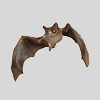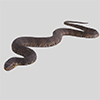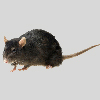Little Rock Wildlife Control
Whether you have a squirrels in your attic, a raccoon problem, a bird or bat issue, snakes, a rat or mouse infestation, skunks, moles and more, we can help.
The Bug Man Inc
We are a professional wildlife control company servicing the Little Rock, Arkansas area. Our line if work is also referred to as nuisance wildlife removal, animal damage control, animal trapping, etc. We specialize in solving conflicts between people and wild animals, throughout Little Rock. Call The Bug Man Inc any time for a phone consultation to learn about their services, at 501-663-9464.

Though some wildlife removal companies also provide general pest control, including insect control, Arkansas animal removal is a specialty service, quite a bit different than the work of a normal exterminator company. Nuisance animal control companies provide
general animal trapping and wildlife prevention, including animal damage repairs. Services may vary, but most companies remove animals in the house or attic like squirrels or rats, and also handle raccoons, opossums, or skunks, bird or bat colony removal, emergency snake or dead animal removal services.
FAQ's
Learn more about The Bug Man Inc of Little Rock, Arkansas.
Services
For an accurate list of services, consult bugman.com. Most animal removal companies provide a complete range of services to solve every wild animal problem in Arkansas. Not just animal trapping and relocation, but wildlife prevention, such as home repairs to close entry holes, fencing around sheds or decks, etc. Dead animal removal and odor control. Emergency services, such as snake removal. Most companies do rodent control of rats & mice, bat colony removal, bird control and prevention, mole trapping, and even attic cleanup. Call 501-663-9464 to check.
Range
Servicing the Little Rock, Arkansas area, but may extend beyond that. If unsure, visit bugman.com or call them at 501-663-9464 to find out their service locations and range.
Hours
Most companies do a pretty good job of answering their phone and being available most days, in particular because animals can be trapped on Sundays, or emergencies can happen those days. But hours may vary. Just call 501-663-9464 to see if they're available.
Reviews
You can read reviews of The Bug Man Inc in Little Rock, AR on sources such as Google My Business listings, Yelp, or even Facebook if they have accounts in these places. You might also find The Bug Man Inc reviews on Home Advisor, Indeed, BBB, Glassdoor, Nextdoor, Angie's List, or more. I don't know the Better Business Bureau rating of The Bug Man Inc, or have links to their Facebook page or Yelp, but it's an easy search away. Of course, online reviews, both good or bad, are often fake for various reasons. Your best bet is to call and find out if you like them! Be sure to talk to a technician, not just a phone receptionist.
Prices
Prices for wildlife control are rarely standardized, because every job is different: the type of animal, number of animals, repairs needed, etc. Call 501-663-9464 for better details.
Contact
The best method of contact is to call 501-663-9464, but if you want to email The Bug Man Inc, visit their website at bugman.com and use the published contact form or email.
Jobs
Is The Bug Man Inc hiring and can you get a job as a critter removal specialist? I don't know - call them and find out.
Animals We Remove
Raccoons cause a variety of problems: they break into attics, damage homes, they steal garbage or pet food, tear up sod, and much more.

Raccoons
Strong & SneakySquirrels commonly enter attics or eaves of homes in the late summer and late winter, where mother squirrels have a nest of young.

Squirrels
Attic InvadersBats love to live in certain buildings, where they can, over time, form huge colonies and leave a lot of guano and urine behind.

Bats
Building ColonizersMost snakes are non-venomous. But many people are unable to correctly identify snake species, and are scared to have these reptiles around.

Snakes
Are they dangerous?Rats and mice commonly enter people's homes, where they can chew electrical wires or wood, eat food, and leave droppings and urine behind.

Rats / Mice
Spread DiseaseOpossums and other ground-dwelling animals such as skunks or groundhogs can dig your yard, rummage pet food or crops, etc.

Opossums
Rummagers / DiggersAbout Arkansas Wildlife
Wildlife of Arkansas Including Pest Species
The state of Arkansas is said to be more than fifty percent forest, providing a wealth of habitats for a wide and diverse mix of wildlife and plant life.
Arkansas Pest Species
All animals have the potential to become a nuisance if they encroach too far into human habitats, or if population numbers increase and upset the balance of a fragile ecosystem. Arkansas has more than a few animals that frequently become pests, on land, in the air, and also in or around various bodies of water.
Countless birds are classed as nuisance animals, including English sparrows, crows, starlings, woodpeckers, pigeons, Canada geese, and blackbirds. Even the double-crested cormorant has been known to pose a problem from time to time.
Birds can wreak havoc in or around properties, leaving droppings all over the place, which then go on to cause a host of other, secondary problems - including blocked guttering, the spread of disease, an unsightly appearance (which can cause a reduction in house prices), and damage to the roof and/or other materials.
Alongside birds, a number of mammals are known to be a pest problem in Arkansas, including striped skunks, nine-banded armadillo (which can also spread leprosy!), various squirrel species, raccoons, opossums, muskrats, coyotes, beavers, and even occasional nutria.
If you're really unlucky, you might spot one of the non-native feral swine populations that are known to exist across almost all of the state. These can be troublesome in terms of damage, but they can also be formidable opponents that have the potential to cause serious injury when provoked. We do not recommend tackling these without the assistance of a licensed, fully-trained wildlife control technician.
Arkansas Amphibians
Despite less than ten percent of the state being water-based (also known as wetlands), Arkansas is still home to an interesting mix of water-based or water-reliant life. The state is thought to be linked to more than thirty species of salamander, and almost the same number of toads and frogs. It's also home to two rather rare species of mussel: the speckled pocketbook and the Arkansas fatmucket.
One of the largest salamanders you might encounter is referred to as the Ozark hellbender, but you are more likely to spot the smaller Ozark zig-zag salamander or western slimy salamander; they tend to spend more time on the ground rather than in water. The hellbender is also listed as an endangered species.
One of the newest salamanders discovered in Arkansas is the Ouachita streambed salamander, first found back in 2014. Many of the Arkansas-specific-named species are only found in the state, or just over the borders, and this includes the Fourche Mountain salamander and Caddo Mountain salamander, both of which have only ever been spotted in this state.
In the frog and toad world, the cricket frog is the smallest found in Arkansas- this is quite common in its natural habitat. On the other end of the size scale, you'll find the large American bullfrog and green frog, both of which are large and considered to be in plentiful numbers.
The most rare species of frogs and toads in Arkansas include the plains, hurter's and eastern spadefoot; and the Illinois, boreal and Strecker's chorus frogs. The squirrel tree frog, western bird-voiced tree frog, western narrow-mouthed toad, plains leopard frog, and crawfish frog are also rare.
Arkansas Bats
Four bats [once] found in Arkansas are classed as threatened or endangered, including the Ozark big-eared bat, northern long-eared bat, Indiana bat, and gray bat. It is thought that only around 16 species of bat now live in the state, which is quite a low number when you compare that to others. (Arizona, for example, is associated with more than 28 different bats.)
One of the fastest bats in Arkansas is the Brazilian free-tailed bat, which can reportedly reach close to 100 mph. The red bat is a fairly common species, and the tri-coloured bat can be found across most of the state. You might also spot the silver-haired bat, Seminole bat, and evening, all of which have been known to encroach on human territories (attics, barns, warehouses, etc.)
On the other end of the scale, the Arkansas Game and Fish Commission have marked a number of bats as species of concern, which means that numbers are declining. These include the Rafinesque's big-eared bat, eastern small-footed myotis, and southeastern myotis.
Arkansas Birds
Arkansas is thought to be (or was) home to many different species of endangered/threatened birds: the whooping crane, Sprague's pipit, red-cockaded woodpecker, red knot, ivory-billed woodpecker, eastern black rail, and piping plover.
More than 100 other species of bird are said to be common in the state, including the barn swallow, occasional bald eagle, belted kingfisher, blue jay, common grackle, downy woodpecker, green heron, horned lark, pine warbler, purple martin, rock pigeon, and yellow-breasted chat.
Arkansas Carnivores
Just a few years ago, you might have spotted the red wolf and the ocelot in Arkansas, but these are now thought to be completely extirpated from the state, which means they no longer can be found there. The state is still home to more than a few other carnivores, however, all of which can be problematic for businesses and residential properties, especially when they started feeding from those locations. (This encourages them to keep coming back.)
The American black bear can sometimes be found in the state, alongside the gray and red fox, bobcats, and cougars, although sightings of the latter are quite rare.
Arkansas Eulipotyphlans
Common eulipotyphlans (the name for shrews, moles, etc.) in Arkansas include the eastern mole, southeastern shrew, desert shrew, least shrew, southern short-tailed shrew, and Elliot's shrew. The eastern mole, especially, can cause serious property damage if left to its own devices, even causing problems with the structural integrity of buildings and other structures, due to vast removal of earth below the surface.
Arkansas Rabbits
The eastern cottontail and black-tailed jack rabbit are two species that you may encounter in the state of Arkansas, alongside the swamp rabbit. These, when they encroach on human habitats, have the potential to destroy crops, ruin back gardens, and cause land stability problems with underground burrows.
Arkansas Reptiles
Seven species of venomous snake can potentially be found in Arkansas, but two of these are rare: the western diamond-backed rattlesnake and Texas Gulf Coast coral snake. The slightly more common species include the eastern copperhead, western pygmy rattlesnake, timber rattlesnake, broad-banded copperhead, and northern cottonmouth.
In total, 44 different species of snake have been linked to Arkansas. The most common sightings are garter snakes, ribbon snakes, earth snakes, ground snakes, and worm snakes - of which multiple subspecies can often be found.
15 species of lizard have also been linked to the state, although one of those isn't believed to inhabit it permanently (Texas spotted whiptail), and two of them are exotic, non-native lizards that have been introduced, accidentally or otherwise, into the area: the Mediterranean gecko and Cuban brown anole.
Rare species of Arkansas lizards include the southern prairie and Great Plains skinks, Texas horned lizard, eastern collared lizard, and western slender glass lizard.
Close to 20 different turtles are thought to call this state their home, too; although more than half of the species are rare and/or on the species of concern list. These include the ornate and three-toed box turtles, three subspecies of map turtles, western chicken turtle, southern painted turtle, and alligator snapping turtle.
There's also one more reptile that we need to mention when talking about Arkansas - the American alligator. This carnivorous beast is classed as endangered in the state.
Arkansas Rodents
This state is home to a number of different rodents, including five different species of squirrel:
• Southern flying squirrel
• Thirteen-lined ground
• Eastern fox squirrel
• Eastern gray squirrel
• Franklin's ground squirrel
And also three species of rat - roof rat, brown rat, and hispid cotton rat.
The state is also inhabited by 13 species/subspecies of mouse:
• Northern pygmy mouse
• Hispid pocket mouse
• Meadow jumping mouse
• Golden mouse
• Texas deer mouse
• Cotton deer mouse
• White-footed deer mouse
• North American deer mouse
• Fulvous harvest mouse
• Eastern harvest mouse
• Western harvest mouse
• Plains harvest mouse
• House mouse
And these are all alongside woodchucks (also called groundhogs), American beavers, two vole species, the marsh oryzomys, eastern chipmunk, Baird's pocket gopher, Plains pocket gopher, and also nutria, also known as coypu. As previously mentioned, some of these can be highly troublesome pest animals.

This is a free listing from Augie of AAA Animal Advertising. It is here because you are either a client of mine, or I'm hoping you will consider hiring me, if your area is available.
A page like this helps your business - it helps more customers find you, your website bugman.com and your phone number 501-663-9464. This web page is a valuable citation that links back to your web site and helps your search engine rankings.
I sell wildlife control leads - through my network of dozens of popular nuisance wildlife websites, I generate hundreds of calls per month in the Little Rock area. My leads are of higher quality
and lower cost than other providers, such as Google Adwords, Home Advisor, Yelp, Angie's List, and others. I typically charge a range of $15 - $20 per customer call you receive. I don't do contracts, you only pay after you get the calls,
you can quit any time. Most of my clients have been with me for 5+ years. I have over 200 clients nationwide, and my clients include Terminix, Critter Control, TruTech, as well as many one-man operations.
If you're interested, email me at augiewildlife@gmail.com, or call me at 747-777-6115, and we'll discuss if your area is available. Many areas are sold out, but I work every day to generate more leads, and
there's a good chance leads are available for you in Little Rock.